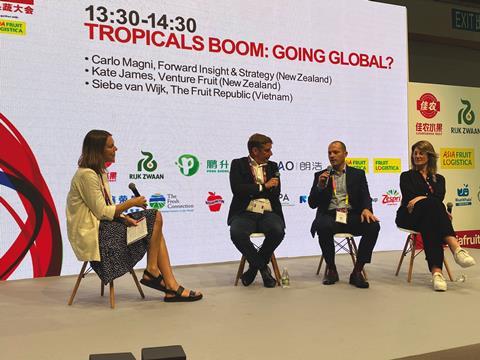Category experts stressed the importance of branding and varietal development as new opportunities emerge in the fast-growing tropical fruit sector
The global market for tropical fruit is on a steep upwards trajectory as consumers seek out exciting new flavours and experiences – but inconsistencies in supply, quality and price are all notable barriers to growth. That was the take-away message from the Asiafruit Congress session on the global ‘tropical boom’ on the final day of Asia Fruit Logistica.

Carlo Magni of New Zealand-based agency Forward Insight & Strategy was joined on stage by Kate James of fruit variety management business Venture Fruit, and Siebe van Wijk of Vietnam’s leading fresh produce exporter, The Fruit Republic. The session, hosted by FPJ features editor Nina Pullman, discussed the key opportunities for growth in the sector, namely how to market tropical fruit, who to target, and what to expect with new varieties coming to market.
Magni reported evidence of the increased appeal and demand for exotic fruit worldwide, quoting 2024 figures from the USDA, which projected significant growth in the next eight years. The global market for exotic fruit market was valued at around US$18bn in 2024 and is expected to reach US$33.7bn by 2033, a CAGR of 7.2 per cent. Asia Pacific is key to this demand, holding a 61 per cent share of the global market.
Magni reported that in China, in particular, demand for durian and dragon fruit continues to increase, which in turn is fuelling growth in South-East Asian markets. In both fruits, this demand has largely been driven by perceptions of health benefits, great-tasting varieties, and visual appeal, he noted.
In tropical fruit more broadly, health consciousness is an important driver for growth, but so is the category’s novelty, with shoppers looking for “exciting and sharable” new experiences. The biggest challenges for tropical fruit suppliers and marketers, Magni pointed out, are the products’ sometimes inconsistent quality and irregular supply, leading to price fluctuations.
The inconvenience of eating some tropical fruits is also a barrier, with Van Wijk saying it has been difficult to convince Dutch consumers to buy Vietnamese pomelo “because they are simply too lazy to peel it”. In response, his business The Fruit Republic has invested in fresh-cut fruit for the European market.
Magni and Van Wijk both see brands as a key vehicle to driving category growth, with Magni adding that varietal advances are helping to reach and satisfy more consumers, more consistently. This is boosting demand, which is opening up new markets and taking share from other fruits, such as berries.
Van Wijk noted that in Europe there is less appetite for brands than in Asia where there is lots of opportunity to build a brand through one of the major supermarkets. In Europe one way to differentiate your product is by building the reputation of a particular country of origin, he said, allowing consumers to navigate towards a product they trust.
On the topic of brands, the big announcement was the upcoming launch of a new dragonfruit brand developed by VentureFruit, the variety management arm of New Zealand fruit heavyweights T&G. With visuals designed to emphasise the fruit’s flamboyant skin and flesh, the brand will be based on new varieties that are resistant to canker. And according to business development manager Kate James, there will be a strategy of quality, consumer messaging, and learnings from the company’s expertise in apple brands such as Envy and Jazz.
Magni stressed that in many tropical fruits the journey from a niche category to one with high volumes and sustained value has only just begun. But what marketers and producers should be aiming for is to replicate the success of trusted brands such as Zespri kiwifruit and Dole pineapples.
This article appears in the upcoming eition of Asiafruit Magazine. For more coverage from the Asiafruit Knowledge Centre visit the Asiafruit App.



